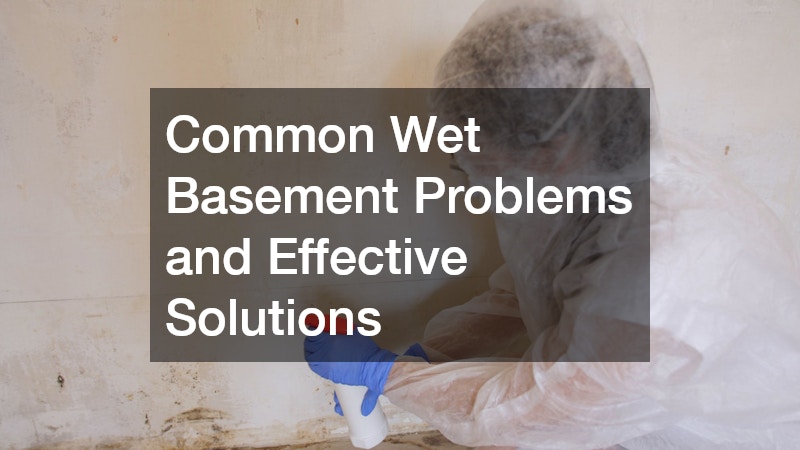In this article, we will explore the common problems associated with wet basements, the potential causes, and effective wet basement solutions to address these issues. Understanding these topics is essential for homeowners looking to maintain a dry and safe living environment.
What Causes a Wet Basement?
One of the primary causes of wet basements is inadequate drainage systems around the home. When rainwater or melted snow does not properly drain away, it can lead to water pooling around the foundation, eventually making its way into the basement.
This may often occur due to clogged gutters, improperly directed downspouts, or even the absence of effective drainage systems like French drains.
Groundwater levels can also significantly impact basement moisture levels. During heavy rainfall or prolonged wet seasons, the ground around your home may become saturated. This saturation can create pressure against foundation walls, resulting in water seeping through cracks or gaps. Understanding how groundwater behaves and how it interacts with your home is crucial for effective basement waterproofing.
How Can You Identify Wet Basement Problems?
Identifying wet basement problems early is vital to prevent potential damage to your home. One of the most apparent signs of water intrusion is the presence of water stains on walls or floors. These stains can vary in color from dark brown to black, indicating where moisture has penetrated and lingered. By regularly checking for these signs, you can take timely action to mitigate further issues.
Mold growth is another significant indicator of moisture problems in a basement. Mold thrives in damp, humid environments and can pose health risks to occupants. It’s crucial to check for patches of mold on walls, floors, or stored items, particularly in corners or areas that seem consistently humid. If you notice mold, addressing the underlying moisture issue becomes imperative to prevent it from returning.
Musty odors often accompany wet basements, signaling hidden moisture problems that should not be ignored. The unpleasant smell can indicate trapped humidity or mold lurking in corners or behind walls. If your basement has a persistent musty smell, it’s essential to investigate the sources of moisture to remediate the issue effectively.
What Are Effective Solutions for Waterproofing a Basement?
Interior sealing is one of the most common methods for waterproofing a basement. This technique typically involves applying sealant to the walls and floors to create a moisture barrier. While this solution can be effective for minor issues, it is important to note that it primarily addresses existing moisture problems rather than preventing future ones. Homeowners may find this approach cost-effective for managing light moisture concerns.
On the other hand, exterior waterproofing is a more comprehensive solution. This method entails excavating the ground around the foundation and applying a waterproof membrane directly to the exterior walls. The installation of drainage systems, such as French drains, often accompanies this method, directing water away from the foundation effectively. While more costly, it provides a long-term solution to protect against water intrusion.
Additionally, ensuring proper drainage systems are in place is crucial for effective basement waterproofing. Investing in functional gutters, downspouts, and grading can significantly minimize the chances of a wet basement. Keeping water away from the foundation is the first line of defense against moisture issues, making it an essential component of any waterproofing strategy.
How to Prevent Future Wet Basement Issues?
Routine maintenance is vital in preventing future wet basement issues. Regularly inspecting gutters for debris, clearing downspouts, and ensuring proper grading around the home are simple tasks that can yield significant results. Implementing a seasonal checklist to assess drainage systems and foundation integrity can help catch potential issues before they escalate.
Additionally, controlling indoor humidity levels is essential for a dry basement. Using dehumidifiers, especially during humid months, can help keep moisture at bay. Proper ventilation is also key; consider adding vents or exhaust fans to promote air circulation and reduce humidity within the basement.
Moreover, landscaping plays a role in prevention as well. Ensure that landscaping features, such as flower beds and shrubs, are designed to slope away from the foundation. This will help direct rainwater away from your home’s base. Implementing these strategies can greatly reduce the risk of moisture intrusion and create a healthier space.
When Should You Consult a Professional for Wet Basement Problems?
Sometimes, addressing basement problems on your own may not be enough, and knowing when to seek professional assistance is crucial. If you experience significant water intrusion, such as persistent flooding after rainstorms, it’s wise to consult an expert. They can perform thorough assessments and help identify underlying issues that you might not be able to detect.
Moreover, if you notice structural concerns, such as large cracks or bowing walls, it’s imperative to engage professionals. These issues can pose severe risks to your home’s integrity and safety. Structural experts have the tools and knowledge to evaluate and remedy such problems effectively, ensuring your basement remains secure.
Understanding common wet basement problems and their solutions can empower homeowners to take proactive steps. Addressing these issues not only improves the home’s livability but also protects its value over time.
